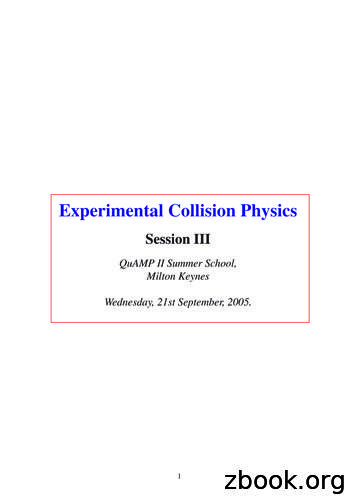Rear-End Collision Warning System Field Operational Test .
Rear-End Collision WarningSystem Field OperationalTest - Status ReportPresented by:David L. Smith, Ph.D., P.E.DivisionDivision ofof AdvancedAdvanced SafetySafety SystemsSystems Research/IntelligentResearch/Intelligent VehicleVehicle InitiativeInitiativeOfficeOffice ofof VehicleVehicle SafetySafety ResearchResearch NHTSANHTSA
Presentation Outline Field Operational Test OverviewCollision Warning SystemOverviewProgram Information
Program Team General Motors Delphi Delco Electronics SystemsDelphi Chassis SystemsHughes Research Laboratories (HRL)University of Michigan Transportation Research Institute(UMTRI)National Highway Traffic SafetyAdministration (NHTSA) - Office ofVehicle Safety ResearchVolpe National TransportationSystems Center
Program Goals Deploy and test a state-of-the-artrear-end collision warning system Measure system performance Estimate real-world safety benefits Obtain information about useracceptance
Program ScheduleJune ‘99Mar ’01Dec ‘01Feb ‘02Phase IEngineeringDevelopmentVehiclesJan ‘03 May ‘04Phase IIPrototypeVehiclePilotVehiclesDeployVehiclesFOT
System Block Diagramand MechanizationBrakeActuatorBrakePedal ollerClass 2 BusSceneTrackingProcessorTargetPath-Estimation& CW Processor(Data Fusion &Threat Assessment)AcceleratorPedal N BusDigital Cell PhoneVisionSystemSensor & VehicleInterface UnitAudioCameraComment ButtonVoice InputHaptic ActuatorClass 2 BusProduction Sensors & SwitchesPRNDLTurn SignalSteering AngleWheel SpeedsBrake PressureThrottle PositionLateral AccelerationBrake Pedal ActiveExtended Brake SwitchYaw RateScene CameraDriver CameraACAS Installed SensorsYaw RateLateral AccelerationLongitudinal AccelerationVertical AccelerationCompass HeadingDataAcquisitionSystemRadioRainHVAC ControlsAudio ControlsOutside TemperatureRoad Surface RoughnessHeadlight Switch PositionWindshield Wiper SettingCompass.)resHeading (lowAmplifierAmbient Noise MicrophoneSpeakerHead-UpDisplayOperator ControlsCruise Control On/OffSet/Coast/Tap Down/Tap UpAccelResume/Headway/SensitivityHaptic On/OffHUD Controls
Forward Vision System Estimate road shape, lane width,vehicle heading, and vehicle lateralposition within the lane using a videocamera.Three university teams support DelphiDelco Electronics: University of PennsylvaniaOhio State UniversityUniversity of Michigan -Dearborn
Map-Based Road GeometryMap-BasedProcessor Predict upcoming road geometry: Differential GPSDigital road mapsDead reckoningDead reckoning from accelerometersaugments DGPS during signaloutages to update host vehicleposition and speed.
Scene Tracking Processor Utilize the trajectories of thepreceding vehicles and roadsideobjects as measured by the radar to: Estimate the upcoming road curvatureDistinguish between in-lane and adjacent lanevehiclesDetermine the heading of the host vehicle in its lane
Forward-Looking RadarForward-Looking Millimeter-wave Monolithic IntegratedCircuit (MMIC) Design Determines kinematic variables of visibletargets Used for both Adaptive Cruise Control and Forward CrashWarningRange (measured), Range-rate (measured), Deceleration(computed)Key Technical Challenges: In-Lane Threats on Curved, Multi-Lane RoadwaysFalse Alarms from Overhead Signs/Bridges
Path Estimation and TargetSelection Uses the Data Fusion outputs for hostpathPredicts path trajectories for host andtargetsSelects the in-path vehicle of interest,either stationary or moving: Accounts for in-lane weaving and drift.Accounts for lane change maneuvers.
Data Fusion and ThreatAssessment Fusion of data to estimate host lanegeometry, host kinematics, driverdistraction, and environment: On-board yaw rate estimatorForward vision systemMap-based road geometry processorScene tracking processorDriver distraction estimatorEnvironmental sensorsCrash threat assessment Driver warning algorithm to energize displays
Driver-Vehicle InterfaceDriver-Vehicle Interface Hardware: Visual Full-Color Head-Up DisplayTonal Alert Delivered over Vehicle Sound SystemCandidate Visual DisplayFormats: Single-Stage Imminent Crash AlertGraded Multi-Stage WarningContinuous Display of Safe Following Information
FOT Data Acquisition System Support Field Operational TestObjectives Crash avoidance estimationsUser acceptance determinationsPresent State of DevelopmentIncludes: System Conceptual DesignList of Recorded VariablesStrategies to Recognize and Capture Critical EventsData Storage and Retrieval ArchitectureTest and Evaluation of a Rapid Prototype
Program Status First Annual Report published Dec 2000Prototype vehicle system integration to becompleted by end of AugustVerification testing will be conducted thisFall (September-November) Interim Report due in January 2002 Phase II to begin in January 2002
Program Contacts andInformation NHTSA Contact: GM Contact: Jack J. FerencePhone: (202) 366 -0168E-mail: jference@nhtsa.dot.govRonald C. Colgin, Ph.D.Phone: (810) 986 -4775E-mail: ronald.c.colgin@gm.comProgram First Annual Report: http://www.nhtsa.dot.gov
System Block Diagram and Mechanization and Mechanization Data Acquisition System FCW Processor (Data Fusion & Threat Assessment) Vision System Haptic Actuator CAN Bus Speaker Sensor & I/O Processor Driver-Vehicle Interface Unit Scene Tracking Processor Target Path-Estimation & Selection Processor ACC/Radar Subsystem ACC Controller Radar Camera
these classes of crashes may be prevented or their effects lessened by using a forward collision warning system (Dogan Ibrahim, 2006). From this we can infer that rear end collision is the
5 1. Collision Physics – An Overview. 1.1 Outline. Collision physics includes ANY collision of a quantum particle with a target. Collision Particles may be: PHOTONS (eg from a Laser, Synchrotron source or FEL) ELECTRONS (usually of well defined momentum from an electron gun) IONS (usually from an ion source of well defin
rear front base pairs rear front 1-pc multi-slot bases ext multi-slot bases rear front rear front anschutz . rear front base pairs rear front 1-pc multi-slot bases ext multi-slot bases rear front rear front} topper 30, 22 jet & mod 158 (pre 1973) 18 60a (48064)} handy rifle 82 (48082) herters} j9 45 (48045) 46 (48046) 402 (48108) s45 (48226 .
California via TIMS, such as the distribution of type of collision in the past three years. 3. System Design Figure 1 shows the end-to-end pipeline of the whole collision analysis system based on DMV AV collision reports and the TIMS datase
display. The systems controlled by the warning systems switch include: Lane Departure Warning (LDW) system Blind Spot Warning (BSW) system Forward Collision Warning (FCW) system When the warning systems switch is turned off, the indicator 2 on the switch is off. If the warning systems switch is illuminated, the enabled systems are on.
This was a part of the Automotive Collision Avoidance System Field Operational Test (ACAS FOT) program sponsored by NHTSA. According to the 2002 National Automotive Sampling System/General Estimates System crash database, light vehicles were involved in approximately 1.8 million police-reported rear-end crashes in the United States or
Oct 14, 2014 · artico dinamica 4wl x a 212 920 39 02 rear cushion cover x a 212 920 32 02 rear cushion cover x a 212 920 91 02 rear cushion cover x a 212 920 99 02 rear cushion cover x a 204 920 25 02 left rear cushion co-ver x a 204 920 26 02 right rear cushion co-ver x a 204 920 08 61 rear cushion cover
body-colored rear roof spoiler high beam control rear privacy glass interior interior dimensions & capacities headroom, front/rear without moonroof (in) headroom, front/rear with moonroof (in) shoulder room, front/rear (in) hip room, front/rear (in) epa cargo volume, rear seatback up/folded (






















